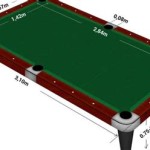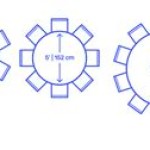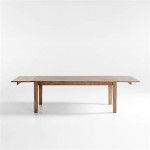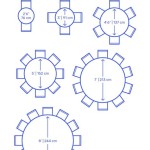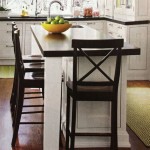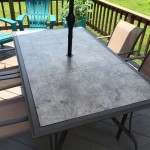Standard Size Round Table: A Comprehensive Overview
The standard size round table is a ubiquitous piece of furniture, found in homes, restaurants, conference rooms, and various other settings. Its popularity stems from its versatile design, which fosters communication and allows for easy interaction among individuals seated around it. Understanding the dimensions, materials, and applications of a standard size round table is essential for making informed decisions when purchasing or utilizing this type of furniture.
The term "standard size" is somewhat broad, as round tables are manufactured in a range of diameters to accommodate varying numbers of people. However, certain sizes are commonly considered standard due to their prevalence and suitability for specific purposes. These standardized dimensions often correlate with the number of diners or users comfortably seated around the table.
Typical Dimensions and Seating Capacity
While precise dimensions can vary slightly between manufacturers, several sizes of round tables are widely recognized as standard. These sizes are generally categorized based on their diameter, which directly influences the number of individuals who can comfortably occupy the space. These dimensions typically consider the amount of elbow room necessary for comfortable dining or working.
A 36-inch round table, also known as a 3-foot table, is often considered a small, standard size. It is typically designed to accommodate two to four people, making it suitable for intimate gatherings, small apartments, or breakfast nooks. This size is ideal for couples or individuals who frequently host small groups.
A 48-inch round table, or a 4-foot table, can comfortably seat four to six individuals. This size is frequently used in smaller dining rooms or kitchens, offering a balance between space efficiency and seating capacity. It is also a common choice for conference tables in smaller meeting rooms.
A 60-inch round table, equivalent to a 5-foot table, is considered a medium-sized standard. It can typically accommodate six to eight people, making it suitable for larger dining rooms or for hosting larger dinner parties. This size is also frequently used in restaurants and banquet halls.
A 72-inch round table, or a 6-foot table, is one of the larger standard sizes. It can seat eight to ten people comfortably, making it appropriate for formal dining rooms, large conference rooms, or event venues. This size provides ample space for place settings and serving dishes.
Common Materials and Construction
Round tables, regardless of their size, are constructed from a variety of materials, each offering different aesthetic qualities, durability, and price points. The choice of material significantly impacts the overall appearance and functionality of the table.
Wood is a popular material for round tables, offering a classic and timeless aesthetic. Hardwoods like oak, maple, and cherry are known for their durability and resistance to scratches and dents. Softwoods like pine are more affordable but may be more susceptible to damage. Wood tables can be stained, painted, or left with a natural finish to complement various interior design styles. The construction of a wooden round table often involves joining multiple planks or using a solid wood disc, depending on the size and desired look.
Glass-top round tables provide a modern and elegant appearance. Tempered glass is commonly used due to its strength and safety features. A glass top can be paired with a variety of bases, including wood, metal, or acrylic, to create different visual effects. Glass tables are easy to clean but can be prone to fingerprints and smudges. The glass is usually bonded to the base using adhesives or mechanical fasteners.
Metal round tables, often constructed from steel or aluminum, offer a sleek and contemporary look. Metal tables are durable and resistant to wear and tear. They can be powder-coated in various colors to match different design schemes. Metal tables are frequently used in commercial settings due to their robustness and ease of maintenance. The metal components are typically welded or bolted together to create a stable structure.
Laminate tables are a more affordable option, offering a wide range of colors and patterns. Laminate is a synthetic material that is bonded to a core of particleboard or MDF. Laminate tables are easy to clean and resistant to stains, but they may not be as durable as solid wood or metal tables. They are commonly used in kitchens, break rooms, and other casual settings. The edges of laminate tables are often finished with banding to prevent chipping and moisture penetration.
Applications in Various Settings
The versatility of standard size round tables makes them suitable for a diverse range of applications, from residential to commercial settings. Their ability to foster interaction and facilitate conversation contributes to their widespread adoption.
In residential settings, round tables are frequently used as dining tables in kitchens, dining rooms, and breakfast nooks. Their circular shape encourages conversation and creates a more intimate dining experience. Smaller round tables are also used as coffee tables or side tables in living rooms and bedrooms. The choice of size and material depends on the size of the room and the overall design aesthetic.
In commercial environments, round tables are commonly used in restaurants, cafes, and banquet halls. They provide a flexible seating arrangement that can be easily adapted to accommodate different group sizes. Larger round tables are often used for conferences and meetings, promoting collaboration and information sharing. The durability and ease of maintenance of the tables are important considerations in these high-traffic environments.
In educational institutions, round tables are used in classrooms, libraries, and study areas. They encourage student interaction and facilitate group projects. Smaller round tables are often used for individual study, providing a comfortable and focused workspace. The tables are typically chosen for their durability and resistance to wear and tear.
Event venues often utilize round tables for weddings, parties, and other special occasions. The circular shape allows for easy interaction among guests and creates a more festive atmosphere. Round tables are typically covered with linens and decorated to match the theme of the event. The ability to accommodate a large number of guests and promote a sense of community makes round tables a popular choice for event organizers.
The height of a standard size round table is also a crucial factor. While counter height and bar height round tables exist, the dimension typically associated with dining room or conference room usage is roughly 29 to 30 inches from the floor to the table top. This height provides ample leg room for average-sized adults, and aligns well with the height of standard dining chairs and conference room seating.
Choosing the appropriate standard size round table requires careful consideration of several factors, including the available space, the intended use, and the desired aesthetic. By understanding the dimensions, materials, and applications of these tables, individuals and organizations can make informed decisions that meet their specific needs and enhance their environments.

Circular Tables Are Space Efficient Designed With A Variety Of Common Diameters Small Roun Round Dining Room Table Sizes

Dining Table Dimensions Measurements
What Size Dining Table Seats 6 Quora

Dining Table Size

Dining Table Size Guide What Do I Need Ask Makers

Dining Table Guide Size Shape Seating Sizes Round

Conference Table Counts Dining Sizes Dimensions Farmhouse

Dining Table Dimensions Measurements

Dining Table Shape And Size Guide By Inspire Q

How To Choose The Size Of A Table
Related Posts

